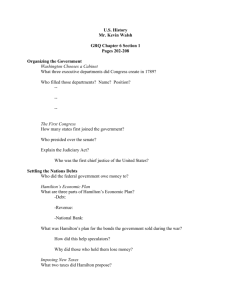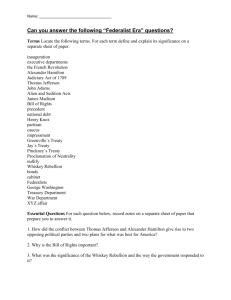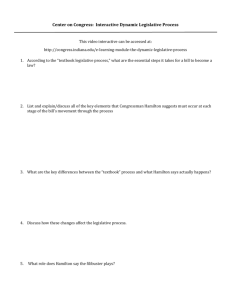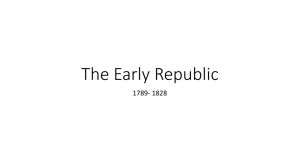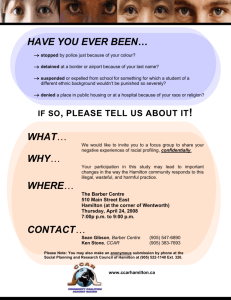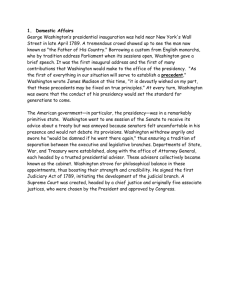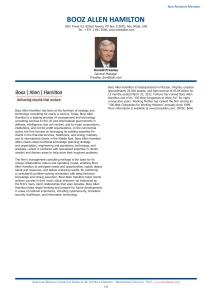Washington's Presidency
advertisement
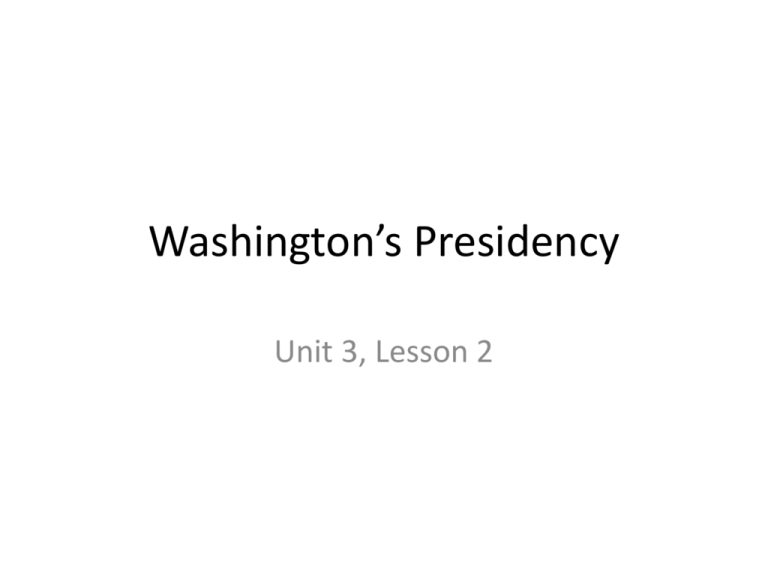
Washington’s Presidency Unit 3, Lesson 2 Essential Idea • America became economically stable but politically divided under Washington, and it faced foreign policy challenges. Congress’ First Actions • Cabinet: • Congress created a group of advisers, the cabinet, to assist Washington • Secretary of StateThomas Jefferson • Secretary of Treasury- Alexander Hamilton Congress’ First Actions • Judiciary Act of 1789: • Created the federal court system • Established district courts, appeals courts, and the Supreme Court Congress’ First Actions • Bill of Rights: • James Madison wrote the Bill of Rights • These amendments protect individual rights and limit the federal government’s power • Major Amendments: • 1st- Freedom of expression • 4th- No warrantless searches • 5th- Due process of law, no double jeopardy, freedom from self-incrimination, eminent domain • 6th- Speedy public jury trial, right to lawyer • 10th- Powers not listed for federal government are reserved for states • The Bill of Rights Funding the Government • • • • • • • • • Economic Issues: Federal government needed a strong economy and to raise revenue to fund itself Tariffs: Tariffs are taxes on imported goods Tariffs raise money to pay for the government Tariffs helped the economy by protecting American businesses from foreign competition However, foreign countries put tariffs on American exports The plan: Alexander Hamilton developed an economic plan for the country • • • • • • • • • • Hamilton’s Financial Plan Part 1: Tariffs and excise taxes Details: Tariff of 1789- Congress passed this tariff on foreign imports Congress also passed an excise tax on whiskey This paid for the government and Hamilton’s financial plan Reactions: North favored it because it protected American businesses South and West were angry because their exports were taxed by other countries South and West were hit hardest by whiskey tax Hamilton’s Financial Plan • • • • • • • Part 2: Pay back war bonds Details: The government paid back money citizens had loaned (war bonds) to pay for the Revolutionary War Reactions: North favored this since they owned most war bonds South and West mad because taxes that hurt them were used to pay back Northern-owned bonds Hamilton’s Financial Plan • Part 3: • Assumption of state debts • Details: • Federal government paid debts states owed • Reactions: • North favored this since they were in the most debt • South and West did not like giving the federal government more power Hamilton’s Financial Plan • • • • Part 4: Bank of the United States Details: The BUS managed the country’s economy, national debt, and national currency • Reactions: • North favored this and owned the most stock in the BUS • South and West thought the BUS was unconstitutional Political Parties Form • Disagreement over Hamilton’s Plan • Political Parties Form: • Debate over Hamilton’s financial plan, especially the BUS, split Congress into the first political parties • These parties were similar to the past Federalist and Anti-Federalist groups Federalist Party • • • • • • • • • • • • • • Party: Federalist Leader: Alexander Hamilton View on Hamilton’s Plan: Favored Hamilton’s plan Government Power? Strong federal, weak states Location of Supporters: North Types of Supporters: Urban, wealthy, businessmen Vision for country: Economy based on manufacturing and commerce (trade) DemocraticRepublican Party • • • • • • • • • • • • • • Party: Democratic-Republican Leaders: Thomas Jefferson View on Hamilton’s Plan: Opposed Hamilton’s plan Government Power? Weak federal, strong states Location of Supporters: South and West Types of Supporters: Less wealthy, farmers Vision for country: Economy based on agrarianism— small independent farms The Whiskey Rebellion (1794) • The Whiskey Rebellion: • Western farmers were angry over whiskey tax • They terrorized tax collectors and disputed courts • Government Response: • George Washington PERSONALLY led 15,000 FEDERAL troops to crush the rebellion Significance of Whiskey Rebellion • Significance: • Such action was impossible under the Articles of Confederation • Stopping the Whiskey Rebellion proved the strength of the new Constitution American Foreign Policy Issues • • • • • • • Events in Europe: The French Revolution, inspired by the American Revolution, got out of hand France declared war on Britain America traded with both countries Political Reactions: Federalists supported Britain due to their strong central government Democratic-Republicans supported France due to their weak central government American Foreign Policy Issues • • • • • • • • Washington: Decided on foreign policy of NEUTRALITY America would not pick a side but would TRADE with both countries British Reaction: Neither Britain or France liked neutrality Impressment- Britain captured American trade ships and kidnapped sailors Britain also used their forts in western America to give Indians weapons to attack settlers with Washington sent John Jay to Britain to avoid war Jay’s Treaty • • • • • • • • • The Treaty: Jay’s Treaty Terms: Britain could continue impressment Britain agreed to give up forts in America (but did not) Britain gave America “most favored nation” trading status (important) Reactions: Americans were furious with the terms France and Spain worried that America was getting closer with Britain Pinckney’s Treaty • • • • • • • • • The Treaty: Pinckney’s Treaty Terms: Settled boundary between America and Spanish Florida Spain let America to use Mississippi River and New Orleans for trade Reactions: Relationship between Spain and America improved Americans were happy due to new land and trade Early American Foreign Policy Westward Expansion • American Settlers: • Settlers wanted to move to the fertile farmland in the Northwest Territory • Native Americans: • Indian tribes reacted angrily, formed a confederacy, and attacked settlers • Conflict and Compromise: • Battle of Fallen TimbersAmerican forces finally defeated Indian forces • Treaty of Greenville- drew a line to divide American territory into land for settlers and Indians
